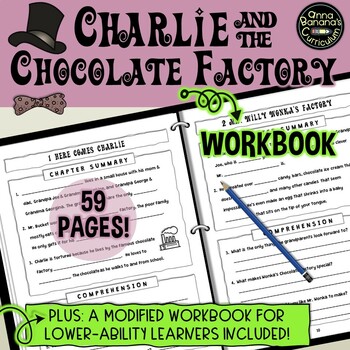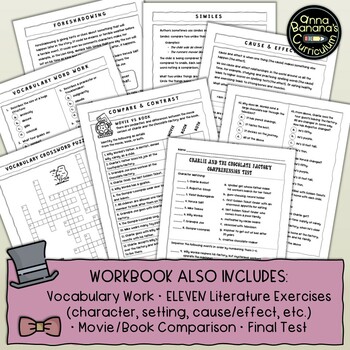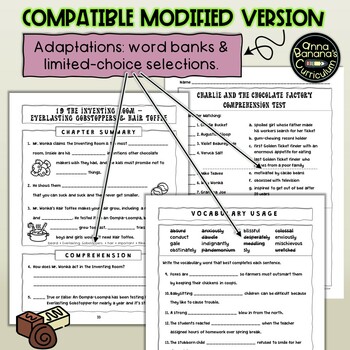Charlie and the Chocolate Factory Workbook: PRINT Novel Study
- PDF
What educators are saying
Description
Guide comprehension, build vocabulary, and teach ELEVEN literature skills (character, setting, figurative language...) with this 59-page workbook for Roald Dahl's Charlie and the Chocolate Factory. This novel study also includes a movie/book comparison guide and a 50-question final test. The resource is available as a PDF and has a MODIFIED WORKBOOK for lower-ability learners. Key included.
For a PRINT AND DIGITAL (Google Slides) version, click here.
WORKBOOK CONTAINS:
- COVER PAGE + TABLE OF CONTENTS (3 pages)
- VOCABULARY WORK (8 pages): 16 vocabulary terms. Worksheets include definition matching, synonyms, multiple-choice word work, crossword puzzle, and vocabulary usage.
- CHAPTER WORK (29 pages): 1 page per chapter, 2 short chapters combined. Each page has a fill-in-the-blank chapter summary and follow-up comprehension work - short answer, T/F, or multiple choice.
- LITERATURE SKILLS EXERCISES (12 pages): Literature skills covered: character analysis, making predictions, foreshadowing, similes, onomatopoeia, setting, cause/effect, point of view, sequencing, and a movie (2005 film) vs book compare/contrast.
- END-OF-BOOK TEST (7 pages): Character matching, sequencing, multiple choice, T/F, and extended response. 50 questions.
The workbook is available as a black + white PDF, convenient for printing. A MODIFIED version is included for struggling learners or lower-ability students. Adaptations include word banks under chapter summaries, limited choices for vocabulary usage work, and condensed matching on the final test. Students who’d benefit from modified curriculum (SPED, lower-functioning...) can complete this COMPATIBLE version along side peers completing the regular version. Key included.
***FOR A FREE CROSSWORD PUZZLE ON CHARLIE & THE CHOCOLATE FACTORY, CLICK HERE. This GIANT summative crossword makes a fun end-of-book activity to help students recall 45+ key details in the book, including characters, places, events, & more.
For a quick & simple resource for Charlie & the Chocolate Factory that's NOT AN EXTENSIVE NOVEL STUDY, try comprehension guide fill-in-the-blank summaries on TRI-FOLD BOOKMARKS or GOOGLE SLIDES. Content from these resources (chapter summaries) are included in the workbook.
Thank you for considering Anna Banana's Curriculum!
TERMS OF USE
Resources are copyrighted as my intellectual property. Permission granted to utilize for single-classroom-use only. This includes in-class work and distance learning. Posting this resource on the Internet for the public to access/download is prohibited. You cannot sell or distribute for free any adaptations of my work to others. Please direct colleagues interested in purchasing the product for their classroom to my TpT store.





